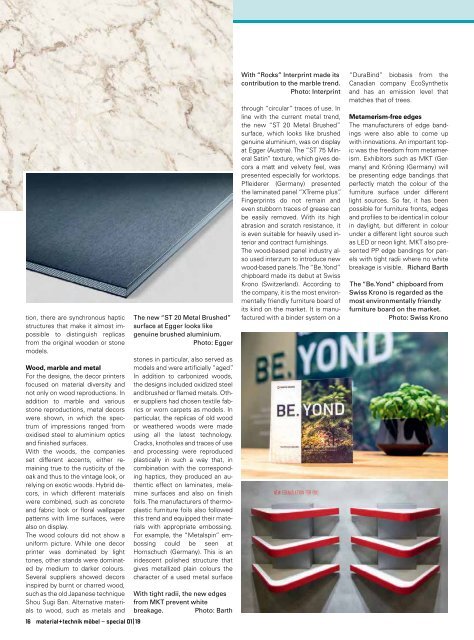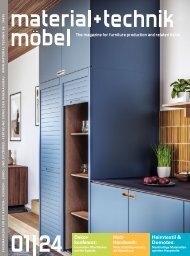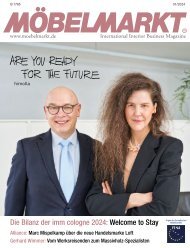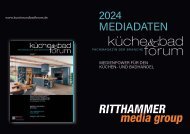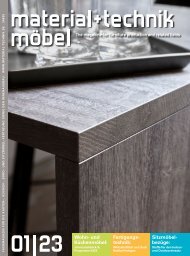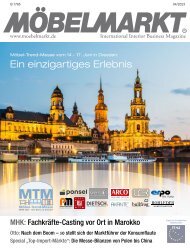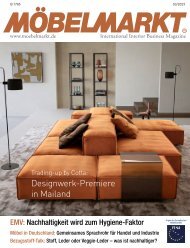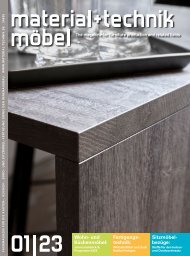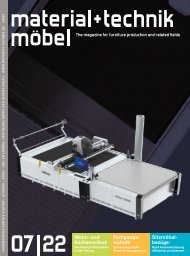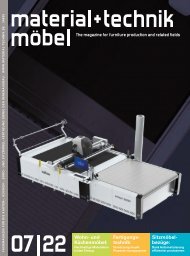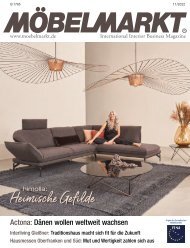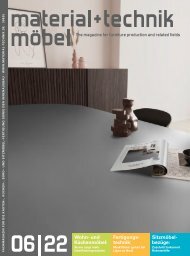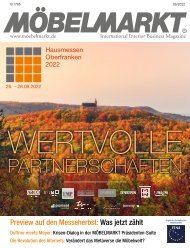Create successful ePaper yourself
Turn your PDF publications into a flip-book with our unique Google optimized e-Paper software.
tion, there are synchronous haptic<br />
structures that make it almost impossible<br />
to distinguish replicas<br />
from the original wooden or stone<br />
models.<br />
Wood, marble and metal<br />
For the designs, the decor printers<br />
focused on material diversity and<br />
not only on wood reproductions. In<br />
addition to marble and various<br />
stone reproductions, metal decors<br />
were shown, in which the spectrum<br />
of impressions ranged from<br />
oxidised steel to aluminium optics<br />
and finished surfaces.<br />
With the woods, the companies<br />
set different accents, either remaining<br />
true to the rusticity of the<br />
oak and thus to the vintage look, or<br />
relying on exotic woods. Hybrid decors,<br />
in which different materials<br />
were combined, such as concrete<br />
and fabric look or floral wallpaper<br />
patterns with lime surfaces, were<br />
also on display.<br />
The wood colours did not show a<br />
uniform picture. While one decor<br />
printer was dominated by light<br />
tones, other stands were dominated<br />
by medium to darker colours.<br />
Several suppliers showed decors<br />
inspired by burnt or charred wood,<br />
such as the old Japanese technique<br />
Shou Sugi Ban. Alternative materials<br />
to wood, such as metals and<br />
16 material+technik möbel – <strong>special</strong> <strong>01</strong>|19<br />
The new “ST 20 Metal Brushed”<br />
surface at Egger looks like<br />
genuine brushed aluminium.<br />
Photo: Egger<br />
stones in particular, also served as<br />
models and were artificially “aged”.<br />
In addition to carbonized woods,<br />
the designs included oxidized steel<br />
and brushed or flamed metals. Other<br />
suppliers had chosen textile fabrics<br />
or worn carpets as models. In<br />
particular, the replicas of old wood<br />
or weathered woods were made<br />
using all the latest technology.<br />
Cracks, knotholes and traces of use<br />
and processing were reproduced<br />
plastically in such a way that, in<br />
combination with the corresponding<br />
haptics, they produced an authentic<br />
effect on laminates, melamine<br />
surfaces and also on finish<br />
foils. The manufacturers of thermoplastic<br />
furniture foils also followed<br />
this trend and equipped their materials<br />
with appropriate embossing.<br />
For example, the “Metalspin” embossing<br />
could be seen at<br />
Hornschuch (Germany). This is an<br />
iridescent polished structure that<br />
gives metallized plain colours the<br />
character of a used metal surface<br />
With tight radii, the new edges<br />
from MKT prevent white<br />
breakage. Photo: Barth<br />
With “Rocks” Interprint made its<br />
contribution to the marble trend.<br />
Photo: Interprint<br />
through “circular” traces of use. In<br />
line with the current metal trend,<br />
the new “ST 20 Metal Brushed”<br />
surface, which looks like brushed<br />
genuine aluminium, was on display<br />
at Egger (Austria). The “ST 75 Mineral<br />
Satin” texture, which gives decors<br />
a matt and velvety feel, was<br />
presented e<strong>special</strong>ly for worktops.<br />
Pfleiderer (Germany) presented<br />
the laminated panel “XTreme plus”.<br />
Fingerprints do not remain and<br />
even stubborn traces of grease can<br />
be easily removed. With its high<br />
abrasion and scratch resistance, it<br />
is even suitable for heavily used interior<br />
and contract furnishings.<br />
The wood-based panel industry also<br />
used interzum to introduce new<br />
wood-based panels. The “Be.Yond”<br />
chipboard made its debut at Swiss<br />
Krono (Switzerland). According to<br />
the company, it is the most environmentally<br />
friendly furniture board of<br />
its kind on the market. It is manufactured<br />
with a binder system on a<br />
“DuraBind” biobasis from the<br />
Canadian company EcoSynthetix<br />
and has an emission level that<br />
matches that of trees.<br />
Metamerism-free edges<br />
The manufacturers of edge bandings<br />
were also able to come up<br />
with innovations. An important topic<br />
was the freedom from metamerism.<br />
Exhibitors such as MKT (Germany)<br />
and Kröning (Germany) will<br />
be presenting edge bandings that<br />
perfectly match the colour of the<br />
furniture surface under different<br />
light sources. So far, it has been<br />
possible for furniture fronts, edges<br />
and profiles to be identical in colour<br />
in daylight, but different in colour<br />
under a different light source such<br />
as LED or neon light. MKT also presented<br />
PP edge bandings for panels<br />
with tight radii where no white<br />
breakage is visible. Richard Barth<br />
The “Be.Yond” chipboard from<br />
Swiss Krono is regarded as the<br />
most environmentally friendly<br />
furniture board on the market.<br />
Photo: Swiss Krono


